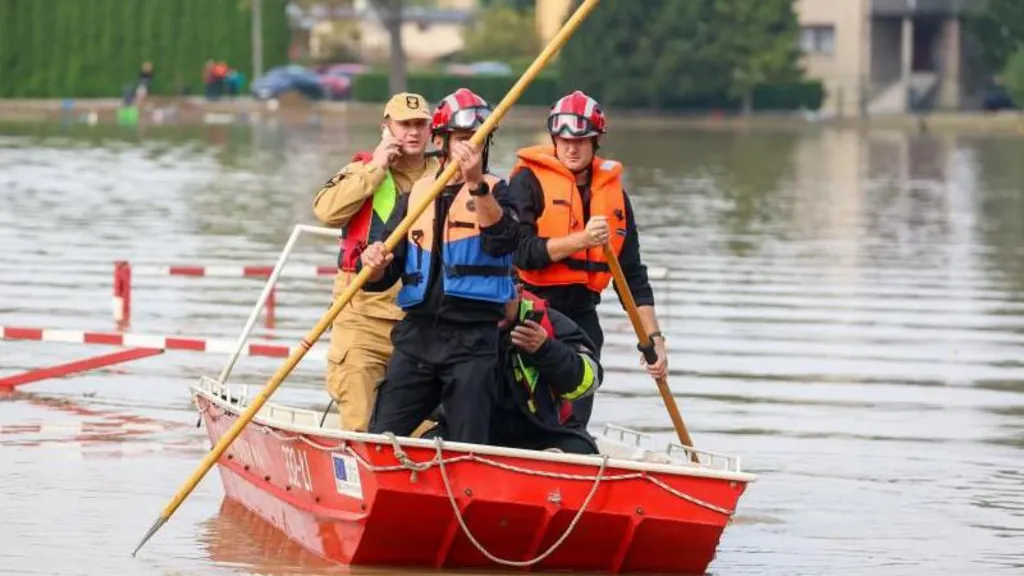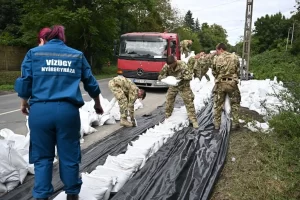Europe Faces Severe Weather Challenges: Italy Braces for Impact After Devastating Floods
3 min read
Rescuers work at flooded areas in Czechowice-Dziedzice, south Poland.

Rescuers work at flooded areas in Czechowice-Dziedzice, south Poland.
Central Europe is grappling with a series of intense storms that have claimed at least 21 lives across the region. The severe weather is now moving towards Italy, where warnings for heavy rain, strong winds, and floods have been issued. The Italian meteorological service has placed much of the country on high alert, from Emilia-Romagna in the north to the southern regions.
Flooding has already hit the central Italian city of Pescara, with extensive warnings covering almost 50 regions. The situation is dire, as intense storms have wreaked havoc in Poland, the Czech Republic, Romania, and Austria over the past week. The storms, driven by Storm Boris, have resulted in massive amounts of rain and snow, leading to widespread devastation.
In Poland, more than 5,000 soldiers have been mobilized to assist the affected communities, particularly in the town of Nysa, from which 40,000 residents have been evacuated. While flood waters are receding in some areas, they continue to rise in others, revealing severe damage in towns like Glucholazy. The town’s main bridge collapsed, and streets have been buried under layers of mud. Polish authorities have confirmed six deaths, but caution against media reports that suggest higher casualty figures. Prime Minister Donald Tusk has declared a month-long state of natural disaster, with the worst flooding expected to impact Wroclaw on Wednesday.
The Czech Republic has also been severely affected, with 15,000 people evacuated from regions along the Czech-Polish border. This marks the worst flooding in over 27 years, according to the NGO Člověk v tísn. Ostrava, in particular, has been hit hard after the Oder River overflowed due to heavy rains.
In Slovakia and Hungary, water levels in the Danube River are rising rapidly. Both Bratislava and Budapest are preparing for potential flooding, with emergency services and volunteers working tirelessly, often supported by the military, to protect low-lying areas. In Austria, elevated water levels have led to the closure of parts of the Danube to shipping traffic.

The Croatian Meteorological and Hydrological Service has warned of an “extremely rare” rise in river levels and has plans to implement flood barriers if needed. Italy’s National Civil Protection Service has issued yellow alerts for nearly 50 regions, highlighting the risk of storms, landslides, and floods. The regions of Emilia-Romagna and Marche are expected to experience significant rainfall, potentially amounting to one or two months’ worth in just three days.
In Pescara, Abruzzo, firefighters have responded to over 200 emergency calls following heavy rainfall that triggered flooding. Romania is also bracing for additional rain in the eastern Carpathians, which threatens towns and villages in Galati and Vaslui counties that have already been severely impacted.
The increasing frequency and intensity of extreme rainfall events across central Europe reflect a broader trend observed globally. While it’s challenging to quantify the exact impact of climate change on these specific events, experts agree that a warmer atmosphere, which holds more moisture, contributes to more intense rainfall. For every 1°C rise in global average temperature, the atmosphere can hold about 7% more moisture. This increase in moisture leads to more severe storms and flooding.
Prof. Hannah Cloke from the University of Reading has noted that extreme rainfall events like these are expected to become more common with rising global temperatures. She highlights that the recent extreme weather in southern and eastern Europe contrasts sharply with the recent droughts, heatwaves, and fires experienced in the region.
As the weather system continues to evolve, Europe faces a challenging period ahead, with ongoing efforts to manage and mitigate the impacts of these severe storms and floods.